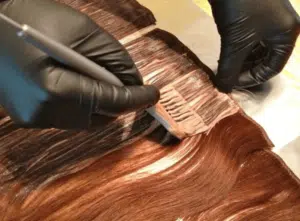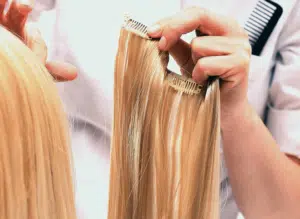As a professional hairstylist, understanding the different types of hair extensions is crucial for providing the best recommendations to your clients. Let’s delve into the pros and cons of tape-in hair extensions, so you can confidently guide your clients and determine if they’re the right fit for your salon.
Tape-in hair extensions are lightweight and provide a natural look, but they require regular maintenance and proper application. They are quick to install and remove, but can cause damage if not correctly cared for.

Explore the detailed benefits and drawbacks of tape-in hair extensions to enhance your service offerings and ensure client satisfaction.
What are Tape In Hair Extensions?
Tape-in hair extensions are a type of permanent hair extension that consists of a 4cm wide weft of hair secured at the top with a sticky tab. This tab uses a gentle medical-grade adhesive, similar to that used in medical plasters, ensuring a secure yet safe attachment to the natural hair. These extensions are installed using a “sandwich” method, where the client’s natural hair is placed between two adhesive strips, creating a secure and seamless fit.

Pros of Tape In Hair Extensions
Natural Appearance: Tape-in extensions lie flat against the scalp, making them virtually undetectable. They blend seamlessly with the natural hair, providing a natural look and feel.
Lightweight: These extensions are light, putting minimal strain on the natural hair and scalp, which is especially beneficial for clients with fine or thin hair.
Quick Installation: The installation process is relatively quick, often taking less than an hour. This makes them an excellent choice for clients looking for a time-efficient solution.
Versatility: Tape-in extensions can be styled like natural hair, including curling, straightening, and washing. They offer a versatile solution for clients who enjoy changing their hairstyles.
Reusable: With proper care, tape-in extensions can be reused multiple times. The adhesive strips can be replaced, allowing the same extensions to be reapplied.

Disadvantages Of Tape In Hair Extensions
Regular Maintenance Required: Clients need to return for maintenance every 6-8 weeks to move the extensions up as their natural hair grows. This is necessary to keep the extensions looking fresh and natural.
Potential Slippage: If not applied correctly or if the adhesive weakens, tape-in extensions can slip. Proper application and care are crucial to prevent this issue.
Heat Sensitivity: Excessive heat from styling tools can weaken the adhesive, leading to slippage or loss of extensions. Clients need to be cautious when using heat styling tools.
Removal Process: While removal is relatively straightforward, it requires a special adhesive remover. Improper removal can cause damage to the natural hair.
Initial Cost: The initial cost of high-quality tape-in extensions and professional installation can be high. However, their reusability can offset this expense over time.

How to Install Tape In Hair Extensions
Preparation
Clean and Dry Hair: Ensure the client’s hair is thoroughly cleaned and dried. This helps the adhesive strips adhere better and last longer.
Sectioning: Divide the hair into small, manageable sections to allow for precise application and ensure the extensions blend seamlessly with the natural hair.
Installation
Peel and Stick: Peel the backing off the adhesive strip and carefully place it near the roots of a small section of natural hair.
Sandwich Technique: Take another strip of tape-in extension and place it under the same section of natural hair, effectively sandwiching the natural hair between the two adhesive strips.
Press Firmly: Press the adhesive strips together firmly to ensure a secure bond.
Aftercare
Advise on Maintenance: Instruct clients to return for regular maintenance appointments to move the extensions up as their hair grows.
Home Care Tips: Provide guidance on how to care for their extensions at home, including using sulfate-free shampoos, avoiding excessive heat, and gently brushing from ends to roots.
Following these steps will help ensure a successful installation and long-lasting, beautiful results for your clients.
How to Remove Tape In Hair Extensions
Preparation
Gather Tools: Ensure you have a special adhesive remover or a solvent designed for tape-in extensions, a fine-tooth comb, and clips to section the hair.
Create a Comfortable Environment: Ensure the client is seated comfortably with all necessary tools within reach.
Removal Process
Apply the Adhesive Remover: Apply the adhesive remover to the tape bonds. Allow a few minutes for the adhesive to soften.
Gently Separate the Extensions: Use your fingers or a tail comb to gently separate the tape bonds. Do not pull or tug to avoid damaging the natural hair.
Comb Out Residue: After removing the extensions, use a fine-tooth comb to remove any remaining adhesive residue from the natural hair.
Clean and Condition: Wash the client’s hair with a gentle, sulfate-free shampoo and follow with a deep conditioning treatment to restore moisture and health to the hair.
Aftercare
Inspect the Hair: Check for any signs of damage or breakage. Provide recommendations for treatments or products to strengthen and repair the hair if necessary.
Plan for Future Installations: Discuss with the client their experience and preferences regarding extensions. If they wish to reinstall tape-in extensions or try a different type, schedule an appointment and provide any necessary pre-installation care instructions.
By following these detailed steps, you can ensure a smooth and safe removal process for tape-in hair extensions, maintaining the health and integrity of your client’s natural hair.

FAQ About Tape In Hair Extensions
Q1: How long do tape-in hair extensions last?
A1: Tape-in hair extensions typically last 6-8 weeks before they need to be adjusted or repositioned. With proper care, the same set of extensions can be reused multiple times, extending their lifespan to several months.
Q2: Are tape-in extensions bad for your hair?
A2: Tape-in extensions are generally safe for your hair if applied and maintained correctly. They use a gentle adhesive similar to medical tape, which minimizes damage. However, improper application, removal, or lack of proper care can cause damage to your natural hair.
Q3: Will tape-in extensions damage fine hair?
A3: Tape-in extensions are a suitable option for fine hair because they are lightweight and distribute weight evenly across the hair strands. Proper application and regular maintenance are crucial to avoid any potential damage, as fine hair can be more susceptible to breakage.
Q4: Are tape-in extensions reusable?
A4: Yes, tape-in extensions are reusable. With proper care and maintenance, the adhesive strips can be replaced, allowing the extensions to be reapplied multiple times. This makes them a cost-effective option over time.
Q5: How to wash tape-in hair extensions?
A5: To wash tape-in hair extensions, follow these steps:
Use a gentle, sulfate-free shampoo to cleanse your hair and extensions.
Apply the shampoo from roots to tips, avoiding the roots and tape bonds.
Rinse thoroughly with lukewarm water.
Apply a lightweight conditioner to the mid-lengths and ends, avoiding the roots and tape bonds.
Rinse out the conditioner completely.
Gently pat your hair dry with a towel and let it air dry or use a blow dryer on a low heat setting.
Q6: What should I do if my client experiences slippage with tape-in extensions?
A6: Ensure the adhesive strips are properly applied and advise the client on proper aftercare. If slippage occurs, reapply the extensions with fresh adhesive strips.
Q7: How should clients sleep with tape-in hair extensions to prevent damage?
A7: Advise clients to braid their hair or tie it in a loose ponytail before sleeping. Using a silk or satin pillowcase can also help reduce friction and protect the extensions.
Q8: Can tape-in hair extensions be dyed or colored?
A8: High-quality human hair tape-in extensions can be dyed or colored, but it’s best to perform any chemical treatments before installation. If clients wish to color their extensions after installation, recommend having it done by a professional.
Q9: What are the signs that tape-in hair extensions need to be removed or replaced?
A9: Signs that tape-in extensions need to be removed or replaced include noticeable adhesive wear, increased tangling, discomfort, and visible damage to the extensions or natural hair.

Conclusion
As a hairstylist, understanding the advantages and disadvantages of tape-in hair extensions allows you to provide informed recommendations to your clients. These extensions offer a natural look and are quick to install, making them a popular choice. However, the need for regular maintenance and proper application should be considered. By weighing these factors, you can determine if tape-in extensions are the best fit for your clients and your salon services.
We are a professional hair extensions manufacturer from China, offering luxury grade wholesale Clip In hair extensions for professionals, please contact us if you have any inquiries or needs





